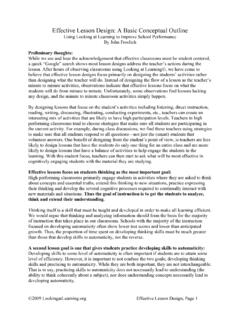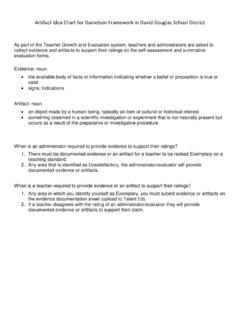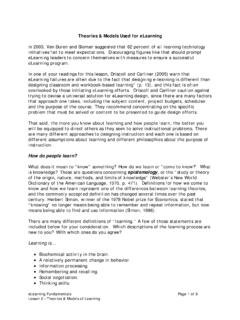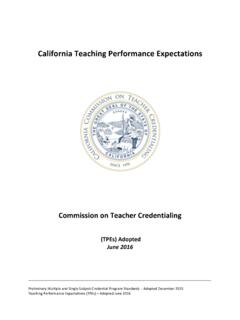Transcription of Core Teaching Practices - Michigan
1 core Teaching Practices 1 Introduction In pursuit of the Michigan Department of Education s (MDE) ongoing goal to maintain the high quality of Michigan s educators, new Clinical Experience Requirements and core Practices for the preparation of Michigan teachers have been created to support the Top 10 in 10 Years Strategic Goal 3 to develop, support, and sustain a high-quality, prepared, and collaborative education workforce and the implementation of the revised certification structure. These requirements complement Michigan s teacher preparation standards to inform program development and continuous improvement efforts at Michigan s educator preparation institutions. The Michigan Department of Education (MDE) has collaborated with a variety of stakeholders across Michigan s education community to revise the teacher certification structure, update teacher preparation standards, and define clinical experience requirements and to assure a quality teacher workforce emerges from these preparation programs ready to teach Michigan s PK-12 students.
2 Supporting the preparation experience is a set of 19 research-based core Teaching Practices that teacher candidates are to develop, practice, and demonstrate appropriate mastery of within their clinical experiences, regardless of grade band or discipline area. Known as High-Leverage Practices , TeachingWorks identified these fundamental competencies that are used constantly and are critical to helping students learn important content. The high-leverage Practices are also central to supporting students social and emotional development. These high-leverage Practices are used across subject areas, grade levels, and contexts. They are high-leverage not only because they matter to student learning but because they are basic for advancing skill in Teaching . 1 These requirements were created with the frame of prioritizing the needs of Michigan s current PK-12 students and producing a quality teacher workforce for Michigan s future students.
3 They reflect current research indicating teacher candidates learn best through clearly and cohesively designed programs that situate teacher learning in the work environment of the PK-12 classroom and upon the expert practice of effective teachers. On the following pages, the 19 core Teaching Practices are identified and described. 1 TeachingWorks. ( ). High-leverage Practices . Retrieved from - Teaching /high-leverage- Practices 2 core Teaching Practices 1. Leading a group discussion 2. Explaining and modeling content, Practices , and strategies 3. Eliciting and interpreting individual students thinking 4. Diagnosing particular common patterns of student thinking and development in a subject-matter domain 5. Implementing norms and routines for classroom discourse and work 6. Coordinating and adjusting instruction during a lesson 7.
4 Specifying and reinforcing productive student behavior 8. Implementing organizational routines 9. Setting up and managing small group work 10. Building respectful relationships with students 11. Talking about a student with parents or other caregivers 12. Learning about students cultural, religious, family, intellectual, and personal experiences and resources for use in instruction 13. Setting long- and short-term learning goals for students 14. designing single lessons and sequences of lessons 15. Checking student understanding during and at the conclusion of lessons 16. Selecting and designing formal assessments of student learning 17. Interpreting the results of student work, including routine assignments, quizzes, tests, projects, and standardized assessments 18. Providing oral and written feedback to students 19. Analyzing instruction for the purpose of improving it 3 core Teaching Practices2 1.
5 Leading a group discussion In a group discussion, the teacher and all of the students work on specific content together, using one another s ideas as resources. The purposes of a discussion are to build collective knowledge and capability in relation to specific instructional goals and to allow students to practice listening, speaking, and interpreting. The teacher and a wide range of students contribute orally, listen actively, and respond to and learn from others contributions. 2. Explaining and modeling content, Practices , and strategies Explaining and modeling are Practices for making a wide variety of content, academic Practices , and strategies explicit to students. Depending on the topic and the instructional purpose, teachers might rely on simple verbal explanations, sometimes with accompanying examples or representations. In Teaching more complex academic Practices and strategies, such as an algorithm for carrying out a mathematical operation or the use of metacognition to improve reading comprehension, teachers might choose a more elaborate kind of explanation that we are calling modeling.
6 Modeling includes verbal explanation, but also thinking aloud and demonstrating. 3. Eliciting and interpreting individual students thinking Teachers pose questions or tasks that provoke or allow students to share their thinking about specific academic content in order to understand student thinking, including novel points of view, new ideas, or misconceptions; guide instructional decisions; and surface ideas that will benefit other students. To do this effectively, a teacher draws out a student s thinking through carefully-chosen questions and tasks and considers and checks alternative interpretations of the student s ideas and methods. 4. Diagnosing particular common patterns of student thinking and development in a subject-matter domain Although there are important individual and cultural differences among students, there are also common patterns in the ways in which students think about and develop understanding and skill in relation to particular topics and problems.
7 Teachers who are familiar with common patterns of student thinking and development and who are fluent in anticipating or 2 These descriptions were authored by TeachingWorks-University of Michigan 4 identifying them are able to work more effectively and efficiently as they plan and implement instruction and evaluate student learning. 5. Implementing norms and routines for classroom discourse and work Each discipline has norms and routines that reflect the ways in which people in the field construct and share knowledge. These norms and routines vary across subjects but often include establishing hypotheses, providing evidence for claims, and showing one s thinking in detail. Teaching students what they are, why they are important, and how to use them is crucial to building understanding and capability in a given subject. Teachers may use explicit explanation, modeling, and repeated practice to do this.
8 6. Coordinating and adjusting instruction during a lesson Teachers must take care to coordinate and adjust instruction during a lesson in order to maintain coherence, ensure that the lesson is responsive to students needs, and use time efficiently. This includes explicitly connecting parts of the lesson, managing transitions carefully, and making changes to the plan in response to student progress. 7. Specifying and reinforcing productive student behavior Clear expectations for student behavior and careful work on the teacher s part to teach productive behavior to students, reward it, and strategically redirect off-task behavior help create classrooms that are productive learning environments for all. This practice includes not only skills for laying out classroom rules and managing truly disruptive behavior, but for recognizing the many ways that children might act when they actually are engaged and for Teaching students how to interact with each other and the teacher while in class.
9 8. Implementing organizational routines Teachers implement routine ways of carrying out classroom tasks in order to maximize the time available for learning and minimize disruptions and distractions. They organize time, space, materials, and students strategically and deliberately teach students how to complete tasks such as lining up at the door, passing out papers, and asking to participate in class discussion. This can include demonstrating and rehearsing routines and maintaining them consistently. 5 9. Setting up and managing small group work Teachers use small group work when instructional goals call for in-depth interaction among students and in order to teach students to work collaboratively. To use groups effectively, teachers choose tasks that require and foster collaborative work, issue clear directions that permit groups to work semi-independently and implement mechanisms for holding students accountable for both collective and individual learning.
10 They use their own time strategically, deliberately choosing which groups to work with, when, and on what. 10. Building respectful relationships with students Teachers increase the likelihood that students will engage and persist in school when they establish positive, individual relationships with them. Techniques for doing this include greeting students positively every day, having frequent, brief, check in conversations with students to demonstrate care and interest, and following up with students who are experiencing difficult or special personal situations. 11. Talking about a student with parents or other caregivers Regular communication between teachers and parents/guardians supports student learning. Teachers communicate with parents to provide information about students academic progress, behavior, or development; to seek information and help; and to request parental involvement in school.

















